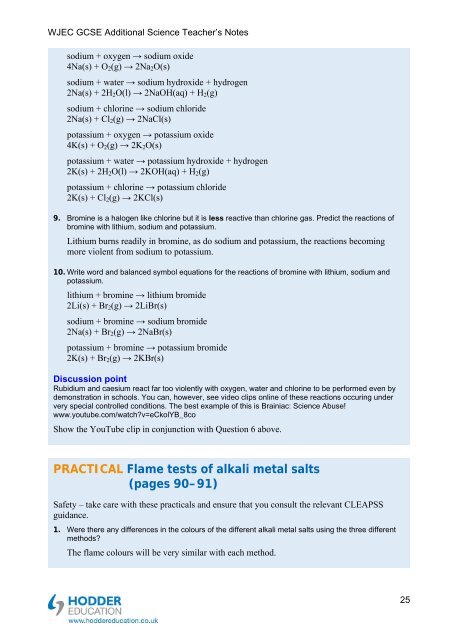Teacher's notes and answers to questions in the book - Hodder Plus ...
Teacher's notes and answers to questions in the book - Hodder Plus ...
Teacher's notes and answers to questions in the book - Hodder Plus ...
Create successful ePaper yourself
Turn your PDF publications into a flip-book with our unique Google optimized e-Paper software.
WJEC GCSE Additional Science Teacher’s Notes<br />
sodium + oxygen → sodium oxide<br />
4Na(s) + O 2 (g) → 2Na 2 O(s)<br />
sodium + water → sodium hydroxide + hydrogen<br />
2Na(s) + 2H 2 O(l) → 2NaOH(aq) + H 2 (g)<br />
sodium + chlor<strong>in</strong>e → sodium chloride<br />
2Na(s) + Cl 2 (g) → 2NaCl(s)<br />
potassium + oxygen → potassium oxide<br />
4K(s) + O 2 (g) → 2K 2 O(s)<br />
potassium + water → potassium hydroxide + hydrogen<br />
2K(s) + 2H 2 O(l) → 2KOH(aq) + H 2 (g)<br />
potassium + chlor<strong>in</strong>e → potassium chloride<br />
2K(s) + Cl 2 (g) → 2KCl(s)<br />
9. Brom<strong>in</strong>e is a halogen like chlor<strong>in</strong>e but it is less reactive than chlor<strong>in</strong>e gas. Predict <strong>the</strong> reactions of<br />
brom<strong>in</strong>e with lithium, sodium <strong>and</strong> potassium.<br />
Lithium burns readily <strong>in</strong> brom<strong>in</strong>e, as do sodium <strong>and</strong> potassium, <strong>the</strong> reactions becom<strong>in</strong>g<br />
more violent from sodium <strong>to</strong> potassium.<br />
10. Write word <strong>and</strong> balanced symbol equations for <strong>the</strong> reactions of brom<strong>in</strong>e with lithium, sodium <strong>and</strong><br />
potassium.<br />
lithium + brom<strong>in</strong>e → lithium bromide<br />
2Li(s) + Br 2 (g) → 2LiBr(s)<br />
sodium + brom<strong>in</strong>e → sodium bromide<br />
2Na(s) + Br 2 (g) → 2NaBr(s)<br />
potassium + brom<strong>in</strong>e → potassium bromide<br />
2K(s) + Br 2 (g) → 2KBr(s)<br />
Discussion po<strong>in</strong>t<br />
Rubidium <strong>and</strong> caesium react far <strong>to</strong>o violently with oxygen, water <strong>and</strong> chlor<strong>in</strong>e <strong>to</strong> be performed even by<br />
demonstration <strong>in</strong> schools. You can, however, see video clips onl<strong>in</strong>e of <strong>the</strong>se reactions occur<strong>in</strong>g under<br />
very special controlled conditions. The best example of this is Bra<strong>in</strong>iac: Science Abuse!<br />
www.youtube.com/watchv=eCkolYB_8co<br />
Show <strong>the</strong> YouTube clip <strong>in</strong> conjunction with Question 6 above.<br />
PRACTICAL Flame tests of alkali metal salts<br />
(pages 90–91)<br />
Safety – take care with <strong>the</strong>se practicals <strong>and</strong> ensure that you consult <strong>the</strong> relevant CLEAPSS<br />
guidance.<br />
1. Were <strong>the</strong>re any differences <strong>in</strong> <strong>the</strong> colours of <strong>the</strong> different alkali metal salts us<strong>in</strong>g <strong>the</strong> three different<br />
methods<br />
The flame colours will be very similar with each method.<br />
25

















